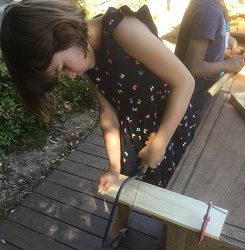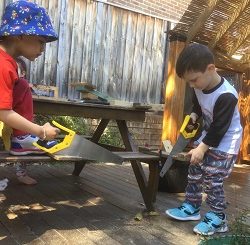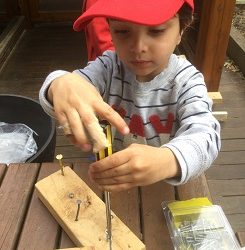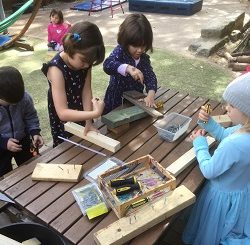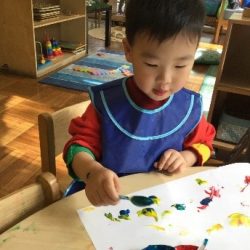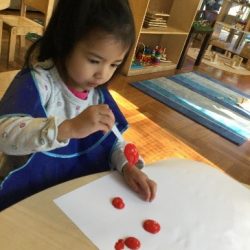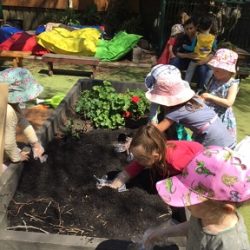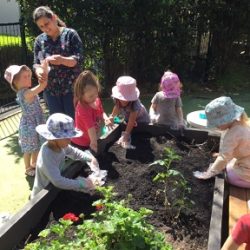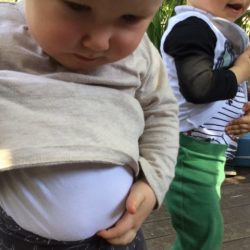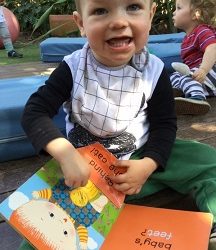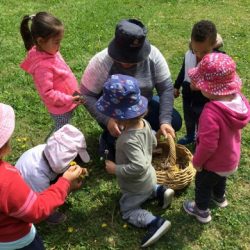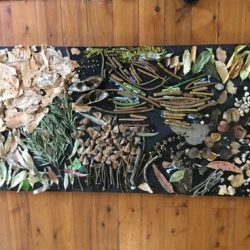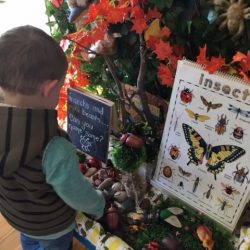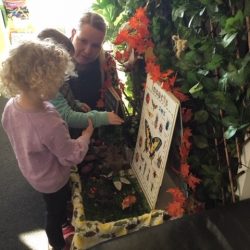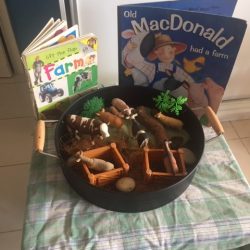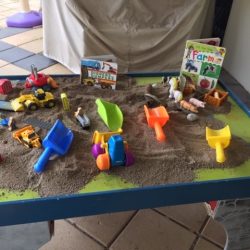Gorton House
We have loved seeing the enthusiasm, confidence and ideas that have flourished as the children in Gorton House preschool continue to explore tools. Over the past couple of weeks we added various elements to the children’s experience with the tools. We brought in some recycled hinges and showed the children how these items help connect separate pieces of wood and allow them to then move in an open/shut motion. We were able to find spaces within our own environment where hinges exist and we showed the children how hinges allow doors to open and shut. Several children then worked together to attach hinges to separate pieces of wood and were delighted with the way the pieces of wood they were attached to could then open and shut.
The other aspect of tool-use we introduced this week that excited so many of the children was the introduction of handsaws. Of course the first thing we did was look closely at the saws, discuss their parts and any risks they posed. Children instantly identified the sharpness of the blades and the possible danger to themselves while cutting if the blades were touched, as well as potential danger to others who might be nearby. As the children took turns handling and then using the saws to cut (while closely supervised) they were able to put their understanding of these dangers into practice. The children explored how a vice helps to keep wood stable and secure on a workbench while they cut it. We found that cutting wood with a handsaw required strength and persistence; many of the children were driven to persist until they saw the impact they had as they cut through the wood. We paid close attention to various types of wood we were sing, and found that some woods were easier to cut/nail through than others, leading to conversations around wood density, and how hard or soft it was.
We had children watching closely as other children cut, and they cheered them on to provide encouragement as they finally cut through wood so that it was in pieces. While all of this sawing was going on, other children were working individually or in pairs on joint projects, as they hammered or screwed pieces of wood together. Two friends spent an entire morning joining several pieces of wood to make an airplane but decided as they progressed that it was actually a digger.
We are planning a trip to Bunnings in order to see if they have any wood offcuts they can spare, and to see what other items might be of interest of use for us. This entire experience has generated a great deal of enthusiasm and interest for many of the children in Gorton House preschool–a very exciting journey for all of us!
Johnson House
Toddlers
Can we make green and orange?
To continue to build on Johnson House toddlers’ children’s existing knowledge of primary colours and some secondary colours, we have recently explored mixing primary colours together. As a provocation for the children’s learning they shared a wonderful book about colour mixing called ‘Mix it up!’ The children were very interested to observe in the illustrations how the coloured paint mixed together and to discover and discuss how we can mix blue and yellow together to make green and that to make orange, we need to mix yellow and red together. As the children used spoons and their fingers to mix colours, they had the opportunity to explore, experiment and discover the learning themselves. The children were very enthusiastic about discovering the new colours they could make.
Preschool
The children in Johnson House preschool have been busy in the garden recently. With the spring weather upon us, we have been planting new flowers, fruits and vegetables. We have been talking about what helps plants to grow and learning the different names of the items we have planted. We have also spoken about being protected in the garden by wearing our hats whilst outside, together with the safe handling of the plants and soil. Each day we gather our watering cans to tend the plants and care for them. We have also been lucky to be able to use the worm farm as a source of nutrients for our garden. During the day we often talk about caring for our land, and gardening is a great example of how we can care for and protect our environment.
Murray House
Infants
The children in Murray House infants’ are showing a great interest in their body parts. The children love looking at themselves in the mirror above them while educators change their nappies, and they interact and connect with educators while their nappies are changed. They giggle and laugh as they make different facial expressions and their favourite word is ‘belly button!’ as they point to their bellies.
To follow this interest, a book about children body parts ‘Where is baby’s belly button?‘ was introduced to the children, and the children were eager to find the baby’s belly, eyes and mouth, and to use some of the prepositioning words to describe where these were hiding. They also respond by pointing to and naming their body own parts as they engaged in reading, allowing them to develop understanding of the meanings of the words. This interest has also been extended through music and movement. ‘One little finger‘ and ‘Head and shoulders’ are some of our children’s favourite action songs. The children enjoy using their little fingers to point to their eyes and nose as they sing and dance. This week the children have begun scaffolding their learning and experiences through shared play—are not only using their body parts to play, but they also love showing their bellies to others and are fascinated to name other children’s body parts too!
Toddlers
Following Murray House toddlers’ children’s interest in the bird’s nest we found a few weeks ago, educator Alisa has been extending their exploration through a variety of experiences. One of the children brought in a bird’s egg shell they found from home, which led to many interesting conversations between the children. For example, they compared it to the eggs they usually see at home or in supermarkets. Perhaps referring to chicken eggs, one of the children commented that other eggs are bigger and are yellow.
Alisa also took the children out for a walk around The Infants’ Home to look for natural materials to make their own nest. Based on what they have learnt from picture books, visual images and discussions, the children gathered some sticks, twigs and dried leaves, just like birds do. Using the natural materials they have gathered from their nature walk, the children experimented to see if they could use them to make their own bird’s nest. As they experimented different ways of making the nest, they also practised their fine motor skills through weaving. This was tricky as the materials were quite delicate and they fell apart easily without glue or string. The challenges reminded them how ingenious birds are in building their nests, as one child commented, “The birds don’t have hands. They only used their beaks to make the nest. Here we are using our hands to make one.” Experiences like these stimulate children’s appreciate for the natural environment, and are great sensory experiences for the children as they explore the textures of natural materials.
Robinson House
Discussion about reduce, reuse, and recycle has continued to be part of our gathering time in the morning in Robinson House. Educator Thi My invited the children to re-purpose an old canvas instead of throwing it away to go into landfill. The children were invited to brainstorm ideas as a collective; many suggested they paint over the old painting, but most said they would like to create a collage.
Taking their ideas on board, Thi My encouraged the children to collect natural resources from our field walks around The Infants’ Home grounds, as well as from our playground, for the project. The walks gave children opportunities to use their senses to explore natural elements of our environment and to appreciate the beauty of every shape, colour, texture, and smell!
Intentional teaching to extend the children’s learning through STEAM (Science, Technology, Engineering, Art, and Math) was used to guide the children to ‘sort’ the found materials and to then use glue to categorise them in groups. A few of the children proudly announced ‘I am a sorting expert!’, and others volunteered to explain to those who had just joined in ‘We have to put them in groups.’ This is a vivid example of children’s learning in a social context through participating in shared learning experiences.
Family Day Care Sydney Wide
During the month of September the Educators at Sydney Wide Family Day Care have been attending Emergent Literacy workshops run by our Service Manager Janice. Emergent Literacy Skills are the basic building blocks for learning to read and write. Part of the training delivered by Janice included the use of props when story telling with children, and Educators were then given a bag of props to use with the children in their service.
Whilst out on visits to Educators’ homes, our Educator Support Officers have been seeing the information the Educators received from the workshops being embedded into their programs for children.
Paula from Lugarno said that she often uses props when reading books with the children to encourage and invite them to extend certain topics, and expand their interests and reinvent ideas. Chi from Kingsgrove used props to tell the story of the three little pigs. The children then retold the story to Chi using the props. Angie from Engadine used props in storytelling to teach the children about insects and world turtle day. Creating a literacy-rich environment provides children with opportunities to explore and use literacy through their daily routines and play.
